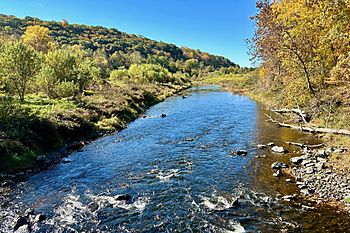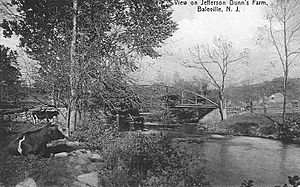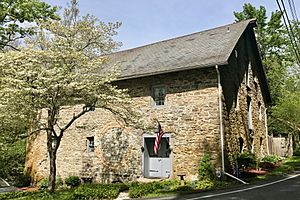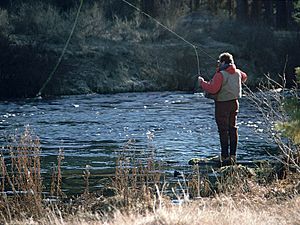Paulins Kill facts for kids
Quick facts for kids Paulins Kill |
|
|---|---|

The Paulins Kill flowing southwest near Warrington, New Jersey
|
|

The Paulins Kill drains an area of 177 square miles (460 km2) in northwestern New Jersey and is part of the Delaware River watershed
|
|
| Country | United States |
| State | New Jersey |
| Counties | Sussex, Warren |
| Physical characteristics | |
| Main source | Fredon Township, Sussex County 750 ft (230 m) 41°04′01″N 74°46′23″W / 41.06694°N 74.77306°W |
| River mouth | Delaware River Knowlton Township, Warren County 262 ft (80 m) 40°55′10″N 75°05′16″W / 40.91944°N 75.08778°W |
| Length | 41.6 mi (66.9 km) |
| Basin features | |
| Basin size | 177 sq mi (460 km2) |
The Paulins Kill is a river in northwestern New Jersey, USA. It flows for about 41.6 miles (67 km) and joins the Delaware River. It's New Jersey's third-largest river that flows into the Delaware. The Paulins Kill drains an area of about 177 square miles (458 km²) across parts of Sussex and Warren counties.
The river starts near Newton, flows north, and then turns southwest. It is located in a hilly and valley area of New Jersey. Long ago, German settlers used the Paulins Kill as a path to new homes in New Jersey and Pennsylvania. Even today, you can see signs of their farms and old buildings.
The Paulins Kill flows through quiet, rural areas. It is a great spot for fly fishing. The land around the river is also popular for hiking and watching wildlife, like birds.
Contents
Where Does the Paulins Kill Flow?
The main part of the Paulins Kill starts forming north of Newton, in marshy areas. Its very beginning is near Route 622 in Fredon Township. From there, it flows southwest through Hampton and Stillwater townships in Sussex County.
A stream called Trout Brook, which comes from Kittatinny Mountain, flows into the Paulins Kill near Middleville. Swartswood Lake also feeds Trout Brook. The Paulins Kill then enters Warren County. Here, it forms a border between Frelinghuysen and Hardwick townships.
The river then flows into Blairstown. Other streams like Blair Creek and Jacksonburg Creek join it there. Finally, the Paulins Kill reaches the Delaware River just south of the Delaware Water Gap. This is near the town of Columbia in Knowlton Township.
In the 1920s, a dam was built across the river in Stillwater Township. This created Paulinskill Lake. People built summer homes there for vacationers from New York City. Today, Paulinskill Lake is a private community with over 500 homes.
What is the Paulins Kill Watershed?
The Paulins Kill watershed is the area of land where all the water drains into the Paulins Kill river. This area is part of the Kittatinny Valley. The Kittatinny Valley is surrounded by mountains. To the northwest are the Kittatinny Ridge and to the southeast are the New Jersey Highlands. High Point, New Jersey's highest peak, is nearby.
The Paulins Kill drains the lower southern and eastern parts of this valley. The water from these areas flows into the Delaware River. Other rivers like the Pequest River and the Wallkill River also drain parts of this valley.
History of the Paulins Kill
How Did the Paulins Kill Get Its Name?
The official name of the river is Paulins Kill. The word Kill is a Dutch word that means "stream."
There's a local story that the river was named after a girl named Pauline. She was said to be the daughter of a Hessian soldier. Hessian soldiers were German soldiers who fought for the British during the American Revolution. Some were held as prisoners near Stillwater, New Jersey. The story says some Hessians stayed in Stillwater because many German people lived there. They thought the river was named "Pauline's Kill." However, maps from the 1740s and 1750s show the name Paulins Kill existed before the Revolution. So, this story is likely not true.
There are two other ideas for the name. One idea is that the wife of an early settler, Johan Peter Bernhardt, was named Maria Paulina. She might have died before the first settlement in Stillwater in 1742.
The most likely reason for the name comes from the Native American name for the nearby mountain: Pahaqualong. This name means "end of two mountains with stream between." It might refer to the Paulins Kill valley or the Delaware Water Gap. There was also an Indian village called Pahaquarra near where the Paulins Kill meets the Delaware River.
A village called Paulina is located near the river. It was named after the stream. The first mill there was built by William Armstrong in 1768.
The local Native Americans, the Munsee tribe of the Lenni Lenape, originally called the river Tockhockonetcong. This name means "stream that comes from Tok-Hok-Nok." Tok-hok-nok was an Indian village near where the Paulins Kill begins today.
Early Settlements Along the River
The first people to live along the Paulins Kill were Native Americans. This was around 8,000 to 10,000 BC, after the last ice age. When Europeans first arrived, the area was home to the Munsee tribe. You can still find Native American tools and artifacts in farm fields nearby.
Many early European settlers were German families. They came to America through Philadelphia between 1720 and 1800. Many traveled north and settled along rivers like the Paulins Kill. Most areas along the Paulins Kill were settled in the 1740s and 1750s.
These German communities often kept their culture for a long time. They built German Lutheran and Reformed churches. Over time, many German families moved west. Those who stayed learned English, and their churches often became Presbyterian. You can still see German influence in the old barns, stone houses, and cemeteries.
English, Scottish, and Welsh settlers also came to the Paulins Kill valley. They often traveled from Philadelphia or from places like Long Island and Newark.
The area around Stillwater was first settled by Casper Shafer and his family in 1742. Shafer ran a mill there starting in 1746. He would send flour and other goods by boat down the Paulins Kill and Delaware River to Philadelphia.
In the 1760s, Mark Thomson built a mill on the Paulins Kill. The town of Marksboro was later named after him.
How Did the River Impact Industry?
The Paulins Kill is mostly a quiet, rural river. It has not been heavily affected by industrial pollution. In the past, dams were built to power small mills for grinding grain or sawing wood. There was also an electrical power plant in Branchville in 1903. Near Columbia, there was a large glass factory. Today, most of these dams are gone or no longer block the river's flow.
Some pollution still reaches the Paulins Kill from nearby homes and farms. This can include runoff from farms with pesticides and fertilizers. Environmental groups work to protect the river.
The Paulins Kill is home to many amphibians, like salamanders, toads, and frogs. In 2000, a project in Branchville was stopped to protect endangered dwarf wedgemussels.
Near Columbia, a huge bridge called the Paulinskill Viaduct was built between 1908 and 1911. It carried the Delaware, Lackawanna and Western Railroad across the Paulins Kill Valley. This bridge was special because it was made of reinforced concrete. It is 1,100 feet (335 m) long and 115 feet (35 m) high. It was the largest concrete bridge in the world for a few years. Today, the bridge is not used for trains, but there are plans to reopen the rail line for passengers. Many people visit this site.
The Paulins Kill Today
The Paulins Kill area remains mostly rural and natural. It's a great place for outdoor activities.
Fishing in the Paulins Kill
The Paulins Kill is a popular spot for fishing, especially for different types of trout. These include rainbow trout, brown trout, and brook trout. The state of New Jersey adds trout to the river each spring. There are not many wild trout because the river gets shallow and warm in the summer. The river is known for fly fishing because of the many mayflies and caddisflies. In the past, American shad fish lived here, but dams stopped them from swimming upriver to lay their eggs. Shad can still be found in the Delaware River.
Protected Areas and Wildlife
The Paulins Kill valley has many protected natural areas. Swartswood State Park, New Jersey's first state park, is located north of Paulins Kill Lake. Parts of Worthington State Forest and Stokes State Forest are also in the watershed.
The Paulins Kill valley is home to many types of trees, including oak, sycamore, cedar, and pine. In the fall, the maple, birch, and hickory trees create beautiful colors.
New Jersey's Green Acres program helps protect the Paulins Kill valley. This program buys land to keep it as open space and farmland. This helps protect nature and provides places for recreation. Both Sussex and Warren counties have preserved thousands of acres of land.
There are also four Wildlife Management Areas (WMAs) in the Paulins Kill valley: Bear Swamp WMA, Trout Brook WMA, White Lake WMA, and Columbia Lake WMA. These areas protect over 6,500 acres of land. Hunting and trapping are allowed in some of these areas during certain seasons.
The Paulins Kill watershed is home to many animals. You might see white-tailed deer, coyotes, red fox, raccoon, beaver, and black bear. Common birds include American robin, blue jay, northern cardinal, and various woodpeckers. You might also spot water birds like wood ducks and mallards. Rarer birds like scarlet tanagers and different types of owls can also be found. Reptiles like northern water snakes and common snapping turtles live here too.
Hiking Trails
The Paulinskill Valley Trail is a long trail that follows old railroad lines. It stretches for 27 miles (43 km) from Sparta Junction to Columbia. This trail is great for hiking, horseback riding, and other outdoor activities. The Appalachian Trail also runs along the top of Kittatinny Ridge, at the northern edge of the valley.
Birdwatching
Birdwatchers can see many different kinds of birds in the Paulins Kill valley. Common birds include robins, blue jays, and cardinals. You might also see woodpeckers, ducks, and hawks. Some rarer birds like purple martins, scarlet tanagers, and different types of owls have been seen here too.
See Also





